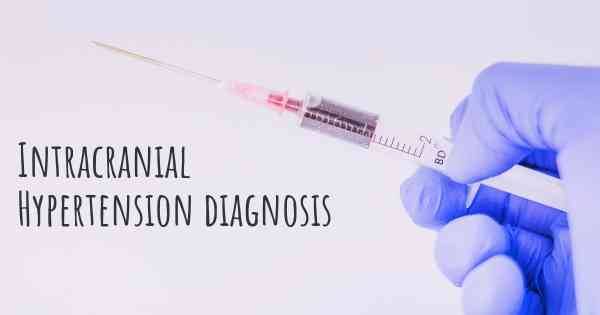How is Intracranial Hypertension diagnosed?
See how Intracranial Hypertension is diagnosed. Which specialists are essential to meet, what tests are needed and other useful information for the diagnosis of Intracranial Hypertension

Diagnosis of Intracranial Hypertension
Intracranial Hypertension (IH), also known as pseudotumor cerebri, is a condition characterized by increased pressure within the skull. It can lead to various symptoms such as severe headaches, vision problems, and even permanent vision loss if left untreated. Diagnosing IH is crucial to initiate appropriate treatment and prevent potential complications.
Medical History and Physical Examination
The diagnosis of IH typically begins with a comprehensive medical history and physical examination. The healthcare provider will inquire about the patient's symptoms, their duration, and any factors that may exacerbate or alleviate them. They will also assess the patient's overall health and perform a thorough neurological examination to evaluate any signs of increased intracranial pressure.
Visual Field Testing
One of the key diagnostic tests for IH is visual field testing, also known as perimetry. This test measures the patient's peripheral vision and can help identify any visual field defects caused by increased intracranial pressure. During the test, the patient focuses on a central point while indicating when they see objects presented in different areas of their visual field. Any abnormalities in the visual field may indicate IH.
Optical Coherence Tomography (OCT)
Another important diagnostic tool for IH is optical coherence tomography (OCT). This non-invasive imaging technique uses light waves to capture detailed images of the retina, which is the light-sensitive tissue at the back of the eye. OCT can measure the thickness of the retinal nerve fiber layer, which is often increased in patients with IH. Therefore, OCT can provide valuable information about the presence and progression of IH.
Lumbar Puncture (Spinal Tap)
A lumbar puncture, also known as a spinal tap, is a procedure in which a small amount of cerebrospinal fluid (CSF) is extracted from the lower back. This fluid is then analyzed to assess its pressure and composition. In patients with IH, the CSF pressure is typically elevated. Additionally, the CSF may show other abnormalities, such as increased protein levels. Lumbar puncture can help confirm the diagnosis of IH and rule out other conditions with similar symptoms.
Imaging Studies
Imaging studies are often performed to evaluate the brain and rule out other potential causes of increased intracranial pressure. The most commonly used imaging technique is magnetic resonance imaging (MRI). MRI can provide detailed images of the brain, allowing healthcare professionals to identify any structural abnormalities or masses that may be contributing to the increased pressure. In some cases, additional imaging techniques like computed tomography (CT) scans may be used.
Other Tests
In certain situations, additional tests may be necessary to aid in the diagnosis of IH. These tests may include blood tests to assess for underlying medical conditions, such as hormonal imbalances or kidney problems, which can contribute to increased intracranial pressure. Additionally, an ophthalmologist may perform an eye examination to evaluate the optic nerve and assess any signs of swelling or damage.
Conclusion
Diagnosing Intracranial Hypertension requires a comprehensive approach involving medical history, physical examination, visual field testing, optical coherence tomography, lumbar puncture, and imaging studies. These diagnostic tools help healthcare professionals confirm the presence of increased intracranial pressure, rule out other potential causes, and determine the most appropriate treatment plan. If you suspect you may have IH or are experiencing symptoms related to increased intracranial pressure, it is important to consult a healthcare professional for a proper evaluation and diagnosis.
Posted Feb 21, 2017 by Kate 1052
Posted Feb 21, 2017 by Colleen 1000
Posted Feb 21, 2017 by Bloomingbeauti 1102
Posted Feb 21, 2017 by Deirdra 1000
Neurology specialists are essential for this condition as IIH is a neurological condition.
Posted Feb 21, 2017 by livvdeluca 350
Posted Feb 21, 2017 by Amy 1495
Posted Feb 22, 2017 by Kathleen 450
Posted Feb 22, 2017 by Diane 1053
A Neuro Ophthalmologist would so a visual field test.
Posted Feb 22, 2017 by Alet 1002
Posted Feb 22, 2017 by leighrach 750
CT scan of your head
MRI of your head
Venogram
Lumbar puncture
Blood tests
Eye exam by a neuro ophthalmologist
Posted Feb 23, 2017 by Rhiannon 450
Posted Feb 24, 2017 by Maryssa 2100
Posted May 18, 2017 by Dr.M 701
Posted May 29, 2017 by Pooja A 600
Posted May 29, 2017 by Talitha 400
In my personal experience, i have been told by my Neurologist that an opening pressure of 25 or higher indicates that intracranial hypertension is present. An opening pressure of 20-25 is a grey area and depending on the person, it can mean that intracranial hypertension is present or it can be seen as normal. Anything lower than this is considered normal.
Seeing a Neurologist is essential when being diagnosed with Intracranial Hypertension and if you have been experiencing vision loss, an opthamologist is also essential.
Posted Aug 11, 2017 by hannah.l18 1100
Posted Aug 12, 2017 by Christy 850
Posted Aug 13, 2017 by LaurynPatterson 1750
Posted Aug 15, 2017 by Mommy2Five 1500
Posted Aug 15, 2017 by Lynne 1600
Posted Aug 18, 2017 by Unique cheatom 2120
Posted Oct 16, 2017 by Melanie 600
Posted Oct 17, 2017 by Lucinda Sara (VDubsTDi) 511
Posted Oct 18, 2017 by Sara 2000
Posted Oct 19, 2017 by Julie 2000
Posted Oct 20, 2017 by Sarah 500
neuro-op, neurologist , Neurosurgery
Posted Oct 28, 2017 by lisa 3365
Posted Oct 29, 2017 by So 2000
Posted Oct 29, 2017 by Dotty 450
A Lumbar Puncture is then required to secure a diagnosis. A diagnosis of intracranial hypertension is given if the opening pressure is above 20-25 (normal range is 10-15). The opening pressure should be measured with the patient in the lateral position for the most accurate reading.
Posted Feb 18, 2018 by Kelly 2560
Once you have been diagnosed you will need to see a Neuro
Posted Feb 18, 2018 by Tiffany-Diane 400
Posted Feb 18, 2018 by Sarahhxoxx 700
Posted Jul 12, 2018 by Michelle 2050
Puncion lumbar
Posted Jun 7, 2017 by Lo 2000
The ophthalmologist has identified papilledema in fundoscopia confirmed with the manimetria and examination of the visual field
Posted Oct 30, 2017 by Valquiria 500








